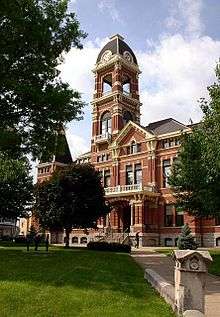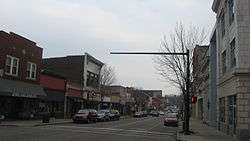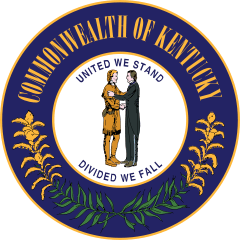Newport, Kentucky
| Newport, Kentucky | |
|---|---|
| City | |
|
Monmouth Street Historic District | |
 Location in Campbell County and the state of Kentucky. | |
| Coordinates: 39°5′19″N 84°29′25″W / 39.08861°N 84.49028°WCoordinates: 39°5′19″N 84°29′25″W / 39.08861°N 84.49028°W | |
| Country | United States |
| State | Kentucky |
| County | Campbell |
| Government | |
| • Mayor | Jerry Peluso (R)[1] |
| Area | |
| • Total | 3.0 sq mi (7.7 km2) |
| • Land | 2.7 sq mi (7.0 km2) |
| • Water | 0.2 sq mi (0.6 km2) |
| Elevation | 512 ft (156 m) |
| Population (2010) | |
| • Total | 15,273 |
| • Density | 6,267.8/sq mi (2,420.0/km2) |
| Time zone | Eastern (EST) (UTC-5) |
| • Summer (DST) | EDT (UTC-4) |
| ZIP code | 41071-41072 |
| Area code(s) | 859 513 |
| FIPS code | 21-55884 |
| GNIS feature ID | 0499438 |
| Website |
www |

Newport is a home rule-class city[2] at the confluence of the Ohio and Licking rivers in Campbell County, Kentucky, in the United States. The population was 15,273 at the 2010 census. Historically, it was one of four county seats of Campbell County.[3] Newport is part of the Cincinnati Metropolitan Area, which includes over 2 million inhabitants.
History
Newport was settled c. 1791 by James Taylor Jr. on land purchased by his father James Sr. from George Muse, who received it as a grant. It was not named for its position on the river but for Christopher Newport, the commander of the first ship to reach Jamestown, Virginia, in 1607.[4] Newport was established as a town on December 14, 1795, and incorporated as a city on February 24, 1834.[4] In 1803, the Ft. Washington military post was moved from Cincinnati to become the Newport Barracks. A bridge first connected Newport to Covington in 1853,[5] and the first bridge spanning the Ohio River to Cincinnati, the John A. Roebling Suspension Bridge, opened in 1866. Newport experienced large German immigration in the 1880-90s.[6]
By 1900, Newport was the third largest city in Kentucky, after Covington and Louisville, although Newport and Covington were rightly considered satellites of Cincinnati.[7]
Newport once had the reputation of "Sin City" due to its upscale gambling casinos on Monmouth street.[8] Monmouth also had many men's stores, nice restaurants, and ice cream parlors.[8] Investigations for racketeering pushed out the casinos, which were replaced by peep shows and adult strip clubs.[8] Many of the old businesses disappeared when parking became difficult on Monmouth Street and the commercial district opened on the hill of south Newport.[8]
A garage at 938 John Street manufacturing illegal fireworks exploded without warning in 1981, leaving severe damage up to a six-block radius.[9]
In the 1980s and 1990s, Newport made plans to develop its riverfront and core to focus primarily on "family friendly" tourism, instead of the "Sin City" tourism of the past. In May 1999 the $40-million Newport Aquarium opened,[10] and the historic Posey Flats apartments were leveled in favor of the Newport on the Levee entertainment complex, which opened the following year.
In 1997 plans were announced for a 1,015-foot (309 m) structure called the "Millennium Tower" were revealed.[11] The tower's main selling point was that building it would be financed by private money, as opposed to taxpayer money.[11] The tower was expected to be completed by 2003,[12] but investors later pulled out and no construction was done. Today the site for the tower is a parking lot next to the World Peace Bell.
Today, Newport is becoming the entertainment community of the fast-growing Northern Kentucky area while its neighboring cities--Bellevue and Covington—become the business centers.[13]
County seat
Newport was the county seat of Campbell County from 1797 until 1823, and again from 1824 until 1840.[14] In the 19th century, the overwhelming majority of the population lived in Newport and the surrounding cities. Many citizens did not like traveling south to Alexandria to conduct county business, as southern Campbell County was primarily undeveloped.
In 1883, Newport successfully lobbied the state legislature for an exception to state law, which both required that a county seat be located in the center of the county, and that certain county business only be conducted at the county seat. Frankfort passed a special law, creating the Newport Court House District, and within that district, the Newport Courthouse Commission which functioned as a special taxing district, so that an additional courthouse could be built, and business could take place in Newport, in addition to Alexandria. In 2008, the Kentucky General Assembly removed the taxing authority from the Courthouse Commission, but left the District and Commission intact.
The special Courthouse Commission legislation has led to a misconception that Newport was also a county seat, and that Campbell County was dual-seated. However, a recent court ruling clarified that, indeed, Alexandria is the only county seat, and Newport is not a county seat.[15] It explained that "In 1840, pursuant to an act of the Kentucky Legislature, the county seat, then located at Newport, was established at Alexandria. No evidence has been presented to this court that this formal designation of Alexandria as the county seat of Campbell County has ever changed. Evidence provided by the Defendants that Newport is considered a county seat or one of two county seats by historians, encyclopedias (editor's note: Wikipedia was cited in this case by the Defendants) and government agencies is based upon practical realities of how county government and the court system have functioned, pursuant to law, in Campbell County for the past 150 years. However, none of the special acts related to the Newport Court House District ever designated Newport as the county seat."
Geography
Newport is located at 39°5′19″N 84°29′25″W / 39.08861°N 84.49028°W (39.088661, −84.490206).[16]
According to the United States Census Bureau, the city has a total area of 3.0 square miles (7.8 km2), of which 2.7 square miles (7.0 km2) is land and 0.2 square miles (0.52 km2) (8.42%) is water.
Newport is located within the Bluegrass region found in the Upland South of the United States of America. Newport is also commonly referred to as being located in the Midwest. Either description of Upland South or Midwest is acceptable, as Newport is located at the boundary between those regions.
Climate
Newport is located within a transition zone and is proximal to the extreme northern limit of the humid subtropical climate of the Southeastern United States.
Demographics
| Historical population | |||
|---|---|---|---|
| Census | Pop. | %± | |
| 1800 | 106 | — | |
| 1810 | 413 | 289.6% | |
| 1830 | 715 | — | |
| 1850 | 5,895 | — | |
| 1860 | 10,046 | 70.4% | |
| 1870 | 15,087 | 50.2% | |
| 1880 | 20,433 | 35.4% | |
| 1890 | 24,918 | 21.9% | |
| 1900 | 28,301 | 13.6% | |
| 1910 | 30,309 | 7.1% | |
| 1920 | 29,317 | −3.3% | |
| 1930 | 29,744 | 1.5% | |
| 1940 | 30,631 | 3.0% | |
| 1950 | 31,044 | 1.3% | |
| 1960 | 30,070 | −3.1% | |
| 1970 | 25,998 | −13.5% | |
| 1980 | 21,587 | −17.0% | |
| 1990 | 18,871 | −12.6% | |
| 2000 | 17,048 | −9.7% | |
| 2010 | 15,273 | −10.4% | |
| Est. 2015 | 15,354 | [17] | 0.5% |
As of the census[19] of 2010, there were 15,273 people, 6,194 households, and 3,273 families residing in the city. The population density was 6,267.8 inhabitants per square mile (2,420.0/km²). There were 7,828 housing units at an average density of 2,878.0 per square mile (1,111.2/km²). The racial makeup of the city was 86.3% White, 7.6% African American, 0.3% Native American, 0.7% Asian, less than 0.01% Pacific Islander, 1.8% from other races, and 3.2% from two or more races. Hispanic or Latino of any race were 4.1% of the population.
There were 6,194 households out of which 23.3% had children under the age of 18 living with them, 28.7% were married couples living together, 17.3% had a female householder with no husband present, and 47.2% were non-families. 37.0% of all households were made up of individuals and 8.9% had someone living alone who was 65 years of age or older. The average household size was 2.32 and the average family size was 3.09.
In the city the population was spread out with 22.2% under the age of 18, 11.1% from 18 to 24, 31.2% from 25 to 44, 25.1% from 45 to 64, and 10.4% who were 65 years of age or older. The median age was 34 years. For every 100 females there were 94.8 males. For every 100 females age 18 and over, there were 91.4 males.
The median income for a household in the city was $27,451, and the median income for a family was $32,858. Males had a median income of $29,337 versus $22,723 for females. The per capita income for the city was $15,207. About 20.7% of families and 22.3% of the population were below the poverty line, including 31.1% of those under age 18 and 16.3% of those age 65 or over.
Arts and culture



Landmarks
- Newport Aquarium
- Newport on the Levee, an entertainment and shopping complex founded by Joshua Treadway of Main Moon Productions and Wallks International
- Thompson House,[20] historic live music venue; birthplace of John T. Thompson, inventor of the Thompson submachine gun
- Corpus Christi Church, Newport now converted into low-costing housing.
- East Row Historic District, the second-largest National Register Historic District in Kentucky
- General James Taylor Park
- Old Post Office
- Masonic Temple, Newport, Ky. .
- Southgate Street School
- Grace Methodist Episcopal Church[21]
- St. Paul's Episcopal Church, built in 1871 completed in 1873, noted for its beautiful stone tower on the Courthouse Square
- World Peace Bell
- Newport Southbank Bridge
Landmarks lost
- Immaculata Academy, Newport, Ky.
- Newport National Bank, circa 1923
- Newport Riverfront circa 1910
- West River Front. Newport
- Church of the Immaculate Conception, Newport
- St. John's German Lutheran Church
- Mount Saint Martin's, Newport
- St. Stephens Church, 9th & Saratoga Sts., Newport
- C. & O. and L. & N. R. R. Depot, Newport, Ky.
- George Wiedemann Brewing Company, Kentucky's largest brewery complex, now torn down for urban renewal, for many years Wiedemann beer was synonymous with Newport
Education
Newport Public Schools are part of the Newport Independent Schools School District. The district has one elementary school, one intermediate school, one middle school, and one high school.[22]
Economy
Local TV is based in Newport.
The Newport Business Association is a trade association focusing on collaboration between local companies. It holds monthly networking and informational meetings.
Notable people
- Mary Anthony, choreographer, modern dancer, and dance teacher.
- Gary Bauer, former Republican presidential hopeful, grew up in Newport [23]
- Dave Cowens, one of the "50 Greatest Players in NBA History", grew up in Newport.
- Vincent Saint John, labor union leader
- Thomas Hinde, physician to Patrick Henry in the Revolutionary War.
- Thomas S. Hinde, Methodist minister, newspaper publisher, and businessman.
- George Miller, baseball player.
- William Shreve Bailey, abolitionist.
Media
A pivotal scene (in which the autistic character Raymond Babbitt counts the toothpicks) in the 1988 film Rain Man was filmed in Newport at Pompilio's Italian restaurant.[24][25]
See also
- List of cities and towns along the Ohio River
- Newport Independent Schools
- Newport Barracks
- Newport Central Catholic High School
References
- ↑ Bailey, Phillip (13 March 2014). "Republican Matt Bevin Receives Endorsement from Northern Kentucky Mayor". WFPL. Retrieved 28 March 2016.
- ↑ "Summary and Reference Guide to House Bill 331 City Classification Reform" (PDF). Kentucky League of Cities. Retrieved December 30, 2014.
- ↑ "Find a County". National Association of Counties. Retrieved 2011-06-07.
- 1 2 Commonwealth of Kentucky. Office of the Secretary of State. Land Office. "Newport, Kentucky". Accessed 4 September 2013.
- ↑ Barker, Thomas; et al. (Oct 10, 2008). Wicked Newport. The History Press. p. 7. Retrieved 2013-05-07.
- ↑ Federal Writers' Project (1996). The WPA Guide to Kentucky. University Press of Kentucky. p. 247. Retrieved 24 November 2013.
- ↑ Shevitz, Amy (2007). Jewish Communities on the Ohio River: A History. University Press of Kentucky. p. 143.
- 1 2 3 4 Hughes, John (January 6, 2000). "For Whom the Bell Tolls". City Beat. Retrieved 2008-09-21.
- ↑ Newport Fire/EMS History Timeline City of Newport. Retrieved 2013-03-11.
- ↑ Vernon N. Kisling, Jr., ed. (2001). "Zoological Gardens of the United States (chronological list)". Zoo and Aquarium History. USA: CRC Press. ISBN 978-1-4200-3924-5.
- 1 2 Ramos, Steve (August 10, 2000). "The Return of Newport's Erection". City Beat. Retrieved 2008-09-21.
- ↑ Flynn, Terry (August 8, 2000). "More than money needed for tower". Cincinnati Enquirer. Retrieved 2008-09-21.
- ↑ Jeffrey McMurray, Associated Press (2007-07-07). "Cities divide to conquer growth". Lexington Herald-Leader/Kentucky.com. Archived from the original on February 5, 2015. Retrieved 2007-07-08.
- ↑ Alexandria and Newport Courthouses, Campbell County Historian Jim Reis
- ↑ Judge: Alexandria the only county seat, The Kentucky Enquirer, 2009-05-12. Accessed 2009-05-28.
- ↑ "US Gazetteer files: 2010, 2000, and 1990". United States Census Bureau. 2011-02-12. Retrieved 2011-04-23.
- ↑ "Annual Estimates of the Resident Population for Incorporated Places: April 1, 2010 to July 1, 2015". Retrieved July 2, 2016.
- ↑ "Census of Population and Housing". Census.gov. Retrieved June 4, 2015.
- ↑ "American FactFinder". United States Census Bureau. Retrieved 2008-01-31.
- ↑ http://www.cincinnati.com/local/newport/E130html_07292003__GNNBDsouthgate.ART_Other.html
- ↑ http://www.cincinnatimemory.org/gsdl/collect/greaterc/archives/HASH3e36/894a6018.dir/ocp000326pccpc.jpg
- ↑ "Newport Independent School District". Newport Independent School District. Retrieved August 18, 2012.
- ↑ Gary Bauer's Moral Dilemma Mother Jones. Retrieved 2013-03-11.
- ↑ Film Locations for Rain Man Retrieved 2013-03-11.
- ↑ Kiesewetter, John (May 16, 2013). "'Rain Man' put Cincinnati on film-world map". The Cincinnati Enquirer. Retrieved 16 December 2013.
External links
| Wikisource has original text related to this article: |
-
 Newport, Kentucky travel guide from Wikivoyage
Newport, Kentucky travel guide from Wikivoyage - City website
- Go2Newport official Main Street website
- Historical Images and Texts of Newport
- History of Newport
-
 "Newport, a city in Campbell co., Ky.". Collier's New Encyclopedia. 1921.
"Newport, a city in Campbell co., Ky.". Collier's New Encyclopedia. 1921.


